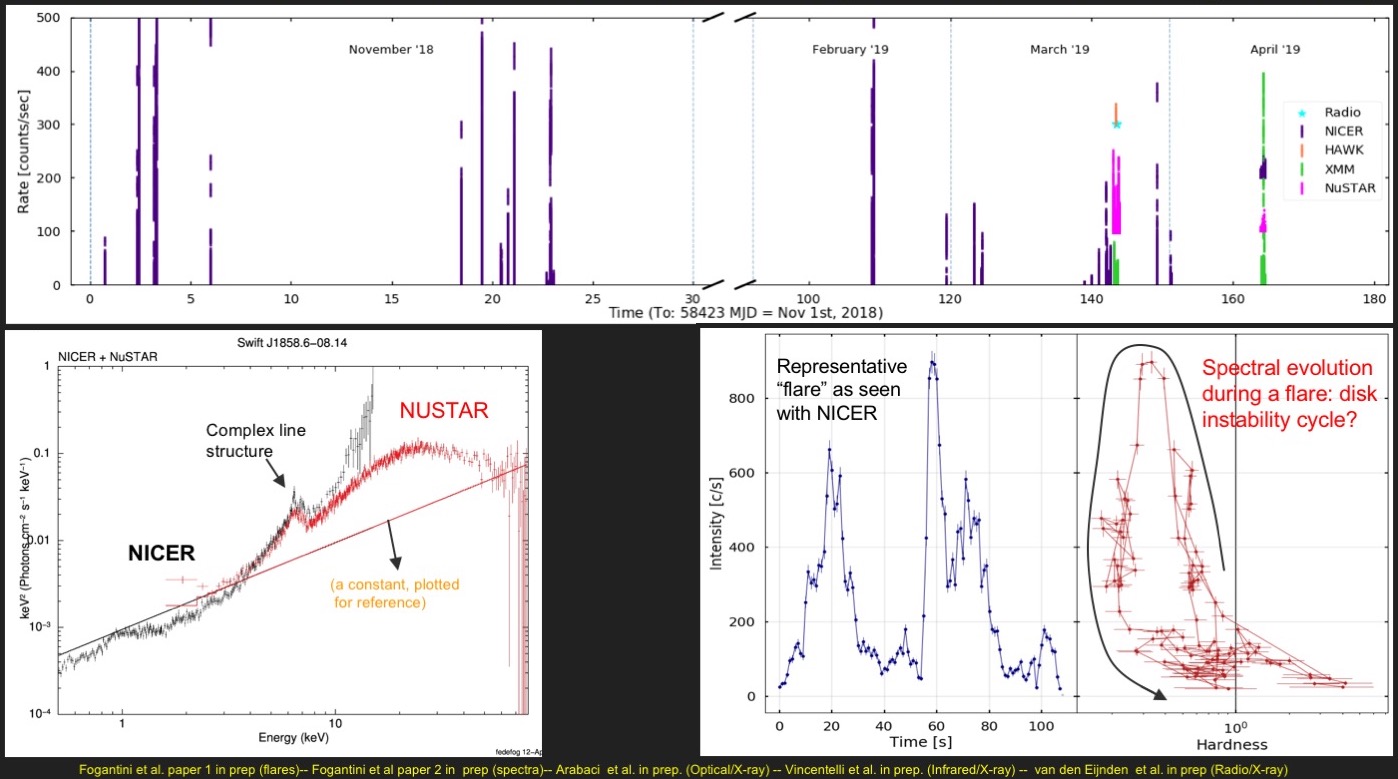NICER / ISS Science Nugget for April 25, 2019Swift J1858.6-0814: A rare, partially-obscured X-ray binarySwift J1858.6-0814 is a new X-ray transient, unknown prior to its discovery by NASA's Swift observatory in October 2018. To date, we do not know the nature of system, but it is probably a low-mass X-ray binary, where either a black hole (of around 10 Solar masses) or a neutron star (~1.4 Solar masses) is pulling gas from a companion star similar to, or older than, our Sun. This new X-ray transient is very unusual, as it does not follow the typical luminosity and spectral evolution expected from black-hole or neutron-star X-ray transients. Swift J1858.6 instead shows intermittent flaring in X-rays, visible, and near-infrared light — we currently do not know whether the flaring extends to other wavelengths. Only one other source has shown similar behavior, albeit far more dramatic. That source, known as V404 Cyg, was last active in 2015 (and previously was only seen in the late 1980s). The "outburst" (i.e., period in which the black hole actively accretes matter from the companion) of V404 Cyg lasted less than a month, and showed the same type of phenomena that we see in Swift J1858.6, except that it was so bright that there were concerns of damage to the X-ray instruments we were using to follow it. Aside from the difference in brightness (which could be due to a difference in distance), Swift J1858.6 has been active for months now, much longer than V404 Cyg. The fact that the outburst is longer and less bright allows us to better plan coordinated observations with multiple facilities. The top panel of the accompanying figure shows light curves from the current campaign, which includes observations done with NICER (soft X-rays), ESA's XMM-Newton (observing both in soft X-rays and optical bands), NASA's NuSTAR (hard X-rays), HAWK-I (near-Infrared, with the Very Large Telescope; Chile), with the Karl G. Jansky Very Large Array (radio; New Mexico) and with the Gran Telescopio Canarias (optical spectroscopy; Canary Islands). In the lower-left panel is shown the X-ray energy spectra obtained with NICER and NuSTAR. The spectrum looks like what is expected from a highly accreting, obscured source, similar to what we see from the nuclei of some active galaxies. There are clear structures — e.g., emission lines — in the energy spectra that we need to study carefully. In the lower-right panel, we show a representative "flare," and parametrize the spectral evolution during the flare using the so-called hardness-intensity diagram. The fact that we see a loop-like evolution during the flare suggests that these flares do follow certain "rules" as they evolve. The most interesting result is that, if our interpretation is correct, the flares are not the result of the system becoming brighter (naive interpretation). Instead, Swift J1858 is always bright but heavily obscured somehow by dense material surrounding the central bright accretion flow, and the apparent flaring is caused by the obscuring gas becoming momentarily less dense. A team of astronomers both in the USA and several countries in Europe is working on the datasets we have obtained. We are only seeing the tip of the iceberg, and in the coming weeks we should have a better understanding on this enigmatic X-ray transient. NICER
|



